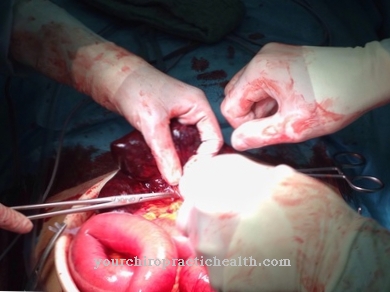The Colonoscopy is also called in medical terminology Colonoscopy refers to and is used for the early detection of colon cancer. During this examination, the large intestine is examined with the help of a special endoscope - this is inserted into the intestine through the anus. The colonoscope has a light source and a camera so that the intestine can be viewed closely. In addition, the attending physician can even use this device to take tissue samples or perform smaller operations. This hose is about ten to 15 millimeters thick.
application

Everyone aged 55 and over can have one once a year as part of early cancer detection Colonoscopy have it done - the health insurance companies will cover the costs.
The colonoscopy is mainly used for the early detection of colon cancer, but it is also used to detect numerous other diseases. In the case of diarrhea and constipation, for example, as well as pain in the abdomen, a colonoscopy is just as often ordered to clarify the causes.
The colonoscopy can not only detect colon cancer, but also other diseases of the digestive tract. Colon polyps, for example, which are generally regarded as a precursor to colon cancer, are detected using this method, as is inflammation of the intestinal wall.
The colonoscopy itself only takes about 15 to 30 minutes and is far less painful than generally assumed. The day before the examination, the patient is given a laxative so that the intestines are thoroughly cleaned of food residues. You should also drink a lot before a colonoscopy. Nothing should be eaten on the morning of the operation, rather the patient is given a mineral-based rinsing solution. The intestine is cleaned with the help of this until it only exudes clear liquid.
During the procedure, the doctor carefully pushes the endoscope into the anus; from there it passes through the rectum into the large intestine. Usually some air is blown in - this is how the large intestine unfolds and is easier for the doctor to see. The colonoscope is so flexible and pliable that it can be inserted up to the mouth of the large intestine in the small intestine, if necessary even a few centimeters into the small intestine.
Since most patients find the procedure quite uncomfortable, a light sedative can be an advantage.
Side effects & risks
Side effects and risks of a Colonoscopy are extremely rare, but can occur in individual cases. A penetration of the intestinal wall, the so-called perforation, can be a risk of this examination. This could lead to inflammation of the peritoneum in the further course. If this is the case, another quick operation is necessary immediately. This type of complication occurs in 1 in 4,000 colonoscopies - a very small percentage.
Secondary bleeding is also possible - this occurs particularly frequently when colon polyps have been removed. Bruises in the intestinal tract are also a possible danger in the context of a colonoscopy - these can be quite painful, but go away by themselves after a few days and are usually harmless to the body.
There is also a potential danger from the sedatives that you may be prescribed before the procedure. You should by no means drive a car after the examination, but if in doubt, let yourself be picked up.












.jpg)



.jpg)










.jpg)
